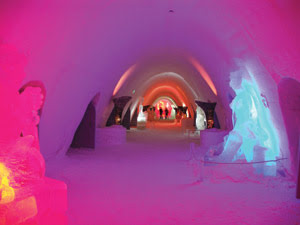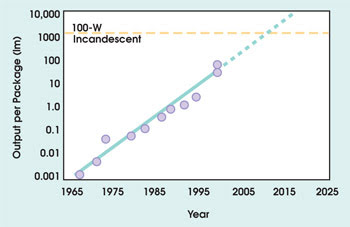Several factors determine the rate of adoption in general lighting.
Niels Haverkorn, Philips Lighting
As the LED comes closer to becoming tomorrow’s general lighting source, several factors will determine its rate of adoption in the market. Predicting that rate is complex because LEDs are not a one-to-one replacement for current light sources. Not only are they highly efficient and durable light sources with a long life span, but they also provide dynamic lighting via the full range of true colors and color temperatures.

The corridor of the Snowcastle in Kemi, Finland, exhibits an unusual application of color LEDs.
And their compact size and programmability allow more freedom in design, opening the path to completely new lighting solutions and even the possibility of embedding them in furniture and walls, for example. In other words, the value and potential of solid-state lighting goes far beyond a mere retrofit of current light sources.
If we look at the rate of adoption of LEDs in the general lighting market, several factors are of importance. They can be categorized in two main groups: evolution of LED technology and market factors. Although each of these plays an important role, it is only a combination of the two that will inspire the lighting market to adopt LEDs on a wide scale.
Evolution of LED technology
The LED industry continuously reports significant improvements in lumens per package. Philips Lumileds Lighting Co. of San Jose, Calif., for example, recently introduced a white LED with a light output of 140 lm. This is in line with Haitz’s law, developed by Roland Haitz, a former scientist at Agilent Technologies Inc. in Santa Clara, Calif., that estimates that the lumen output per package will keep increasing at a rate of 20 times in each decade, while prices will fall by a factor of 10 (Figure 1). As LEDs advance according to the Haitz curve, adoption of the devices will accelerate within the general lighting industry.

Figure 1. LEDs have rapidly improved in lumen output per package, according to the Haitz curve shown here. Courtesy of Roland Haitz.
Another factor is the consistency of color, among devices and over time. The new binning schemes (the basis for customers to select the appropriate color and color temperature) are good news. Furthermore, some of the latest introductions on the market, such as Philips’ Intuos Multi-die LED technology, make use of integrated electronics and sensors that continuously adjust color and flux to ensure consistency.
Another area that receives a good deal of attention by the lighting industry is the development of an intuitive user interface control. Allowing consumers to easily set controls such as dim, color points and color temperatures is necessary to truly reveal the value of LEDs.
The more industrywide standards and measurements we introduce, the quicker the market will accept and adopt LED technology. This requires a joint effort by everyone in the industry as well as a re-examination of current well-known methods. For example, some questions have been raised regarding the suitability of the current method of measuring the color rendering index, which is a description of the effect of a light source on the natural color appearance of an object.
Market readiness for LEDs
LEDs must attain a certain maturity to really take off. This implies that the efficiency and cost of an LED for a given application must approximate those of the currently available light solutions before it can arouse the interest of consumers. For example, for applications such as traffic lights and backlighting for cars, this point has been reached; for general office lighting, however, it has not.
But the future is bright, according to Robert V. Steele of Strategies Unlimited in Mountain View, Calif. At this year’s Strategies in Light Conference in San Francisco, he predicted that the general lighting market will grow from its current level of $250 million to about $1 billion by 2010.
Meet the author
Niels Haverkorn is marketing manager at the Business Unit Solid State Lighting Div. of Philips Lighting in Eindhoven, the Netherlands; e-mail: [email protected].